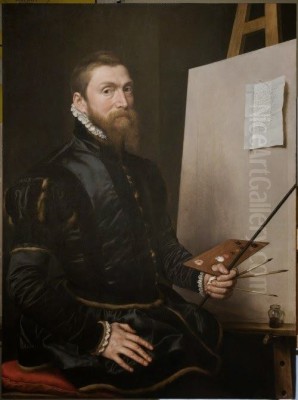
Antonis Mor van Dashorst, known across Europe by various names including Antonio Moro and Antonius Mor, stands as one of the most significant portrait painters of the 16th century. Born in the Dutch city of Utrecht around 1516 to 1519, he rose from provincial beginnings to become a favoured artist in the highest circles of European power, particularly the Habsburg courts of Emperor Charles V and his son, Philip II of Spain. Mor's career was truly international, taking him to Italy, Spain, Portugal, and England, where he absorbed diverse artistic influences and forged a distinctive style that profoundly shaped the course of court portraiture for generations. His ability to combine the meticulous detail characteristic of Northern European painting with the grandeur and psychological depth of the Italian Renaissance made his work highly sought after by monarchs, nobles, and wealthy merchants alike.
Utrecht Beginnings and the Shadow of Scorel
The foundations of Mor's artistic journey were laid in his native Utrecht, a prominent city in the Northern Netherlands. Crucially, he entered the workshop of Jan van Scorel (c. 1495–1562), the leading painter in Utrecht at the time. Van Scorel was himself a pivotal figure, one of the first Dutch artists to travel extensively in Italy, absorbing the lessons of the High Renaissance, particularly the works of Raphael and Michelangelo. He brought this Italianate influence back to the North, blending it with the established Netherlandish tradition.
Under Van Scorel's tutelage, Mor would have received rigorous training in drawing, composition, and oil painting techniques. He likely learned the Northern penchant for detailed realism, precise rendering of textures, and careful observation. Simultaneously, Van Scorel's own experience would have exposed Mor to the possibilities of a more monumental style, a greater emphasis on classical forms, and the burgeoning potential of portraiture to convey status and personality, moving beyond the purely devotional focus of earlier Netherlandish art. Some early, though sometimes disputed, works are attributed to this period, including portraits possibly painted in Stockholm around 1538 and a series depicting Knights of St. John from around 1541, hinting at his developing skill even before his major career phase began.
Antwerp and Early Success
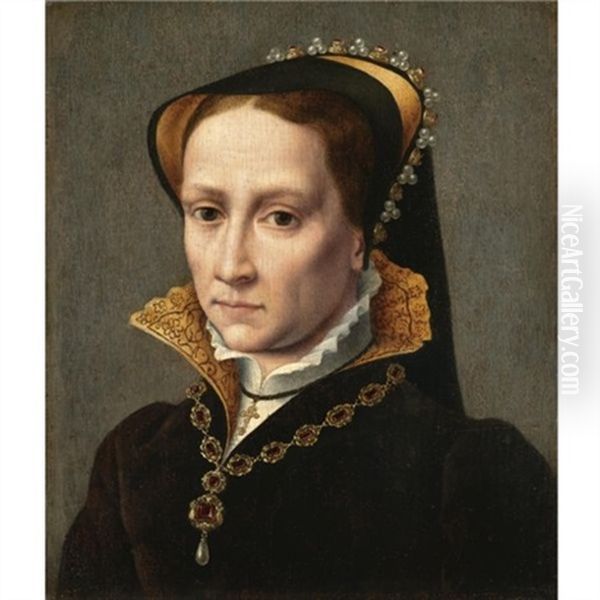
By 1547, Antonis Mor had moved to Antwerp, the bustling commercial and artistic hub of the Low Countries. This move was significant, placing him at the centre of a vibrant international art market. In that year, he was admitted as a master into the prestigious Guild of Saint Luke, a necessary step for establishing an independent workshop and taking on pupils. It was likely in Antwerp that he began to attract the attention of influential patrons.
One of his most important early supporters was Antoine Perrenot de Granvelle (1517–1586), Bishop of Arras and later Cardinal Granvelle, a key statesman in the service of Emperor Charles V. Granvelle was a sophisticated connoisseur and patron of the arts, and his support provided Mor with crucial access to the Habsburg court circle. Mor painted several portraits of Granvelle over the years, capturing the clergyman's shrewd intelligence and political gravitas. This connection proved instrumental in launching Mor's international career, opening doors to the highest echelons of European society. Antwerp, with artists like Frans Floris (c. 1519–1570) also active, provided a competitive yet stimulating environment for the ambitious young painter.
The Italian Sojourn: Absorbing the Renaissance
Like his master Jan van Scorel before him, Mor recognized the importance of experiencing Italian art firsthand. Around 1550, he embarked on a journey south, spending time primarily in Rome and possibly Florence. This period was crucial for refining his style and broadening his artistic horizons. In Italy, he immersed himself in the study of both classical antiquity and the works of the High Renaissance masters.
Of particular importance was his encounter with the art of Titian (Tiziano Vecellio, c. 1488/1490–1576), the Venetian master renowned for his powerful portraits and rich use of colour. Mor is known to have studied and even copied Titian's works, including a version of the famous Danaë. He absorbed Titian's ability to convey majesty and psychological depth, his sophisticated handling of light and shadow, and his rich, painterly technique. However, Mor did not simply imitate; he synthesized these Italian influences with his Northern training, retaining a characteristic precision and detailed finish while adopting a newfound monumentality and psychological penetration. His time in Italy solidified his ability to create portraits that were both lifelike representations and imposing statements of power and status, perfectly suited for courtly patrons. He would have also been aware of the towering legacies of Michelangelo (1475-1564) and Raphael (1483-1520) during his time in Rome.
An International Career: Serving the Habsburgs
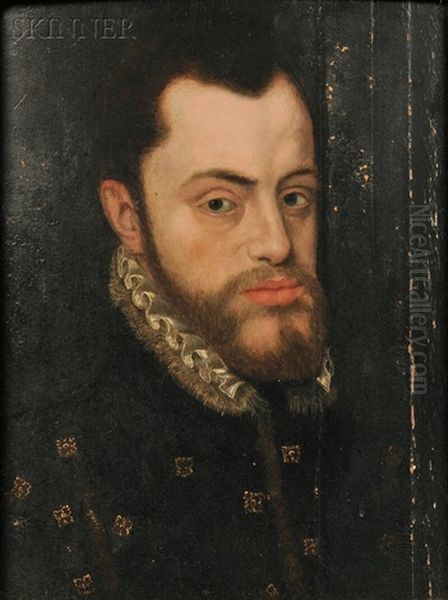
Armed with his refined skills and powerful connections, Antonis Mor became one of the most sought-after court painters in Europe. His association with Cardinal Granvelle led to commissions from Emperor Charles V himself. Following Charles V's abdication, Mor entered the service of his son, Philip II, King of Spain. This relationship would define much of his career, involving extensive travel and numerous prestigious commissions.
Mor's role often extended beyond simply painting; he acted almost as an artistic diplomat, travelling to various courts on behalf of his patrons. In 1550-1551, he was sent to Lisbon to paint the Portuguese royal family, including King John III, Queen Catherine of Austria (Philip II's aunt), and their children, notably Prince John, whose portrait exists in several versions, attesting to its importance and Mor's practice of producing replicas. These works helped solidify dynastic ties and served as important visual records for the interconnected European monarchies.
His travels continued, taking him back and forth between the Netherlands (particularly Brussels, a key Habsburg administrative centre), Spain, and other territories. His ability to navigate the complex world of court etiquette while producing consistently high-quality portraits made him invaluable to Philip II. He captured the reserved, devout, and authoritative persona of the Spanish king in several iconic portraits that set the standard for Spanish royal imagery for decades.
The Portrait of Mary Tudor: A Royal Commission
One of Mor's most famous assignments occurred in 1554 when Philip II dispatched him to London. His mission was to paint a portrait of Queen Mary I of England (Mary Tudor, 1516–1558), Philip's bride-to-be. The resulting portrait, now housed in the Museo del Prado in Madrid, is a masterpiece of court portraiture and a fascinating historical document.
Mor depicted Mary seated, richly dressed, holding a rose (a Tudor emblem) and wearing the magnificent pearl and diamond jewel ('La Peregrina') sent to her by Philip as a betrothal gift. The portrait is executed with Mor's characteristic blend of meticulous detail – rendering the textures of velvet, satin, and jewels with astonishing realism – and psychological insight. Mary's expression is somber, almost melancholic, yet imbued with a sense of regal dignity and determination. Mor avoids flattery, presenting a realistic portrayal of the Queen, adhering perhaps to the Habsburg preference for sober representation. The work masterfully conveys her status and the significance of the impending dynastic union. It stands in contrast to the often more idealized portraits produced earlier for the English court by artists like Hans Holbein the Younger (c. 1497–1543), showcasing Mor's distinct, slightly more austere but deeply penetrating style.
Master of the Court Portrait
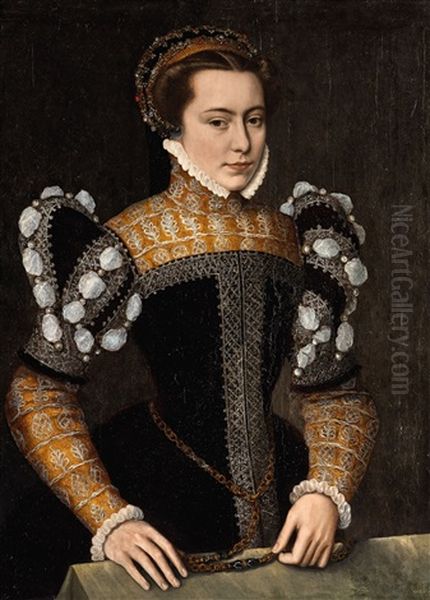
Antonis Mor excelled in the specific demands of court portraiture. His style became synonymous with the formal, dignified representation favoured by the Habsburgs and other European ruling families. His portraits typically feature half- or three-quarter length figures, often set against dark, neutral backgrounds that focus attention entirely on the sitter. He paid extraordinary attention to the details of costume, jewellery, and insignia, understanding their importance in conveying rank and wealth.
Yet, his work transcends mere surface description. Mor possessed a remarkable ability to capture the sitter's presence and personality, often conveying a sense of reserved authority, intellectual depth, or quiet introspection. While influenced by Titian's grandeur, Mor's approach was generally more restrained, his brushwork tighter, and his psychological portrayal more subtle than overtly emotional. He achieved a delicate balance between realistic representation and the necessary idealization required for official portraiture, creating images that were both convincing likenesses and powerful symbols of status. This combination of Northern precision and Southern European gravity defined his unique contribution to the genre.
Key Patrons and Portraits
Beyond Philip II and Mary Tudor, Mor painted a wide array of prominent figures across Europe. His portrait of Empress Maria of Austria (1528–1603), wife of Emperor Maximilian II and sister of Philip II, is another quintessential example of his Habsburg court style, emphasizing her piety and regal bearing. His depictions of Cardinal Granvelle chart the statesman's rise, showcasing Mor's ability to adapt his portrayal to reflect changing status and age.
His clientele also included wealthy merchants and intellectuals. The companion portraits of the English financier Sir Thomas Gresham (c. 1519–1579) and his wife Anne Ferneley, painted during Gresham's time as a financial agent in Antwerp (now in the Rijksmuseum), demonstrate Mor's skill in portraying non-royal sitters with dignity and psychological acuity. These works highlight the growing importance of the merchant class and their desire for representation by leading artists.
Other notable works include the striking Portrait of a Knight of the Order of St James, where the dramatic lighting and strong pose convey martial vigour, and several compelling self-portraits. In his self-portraits, Mor presents himself as a confident, successful artist, sometimes including attributes of his profession, offering a glimpse into his own persona and status within the society he depicted. The portrait of Ottavio Farnese, Duke of Parma, is another significant work, notable also for having been misattributed to Raphael at one point, highlighting the quality that led to such confusion.
Beyond Portraiture: Religious Themes
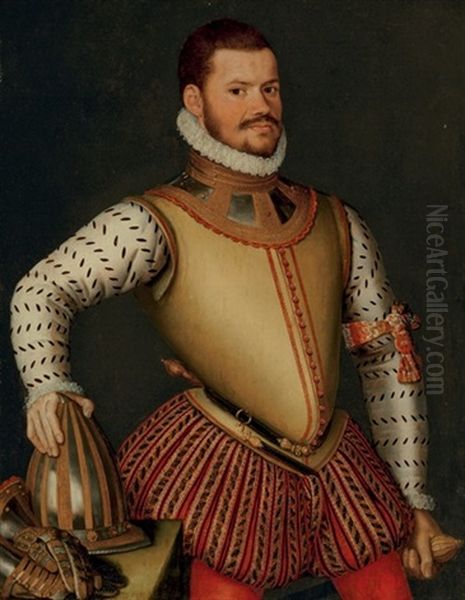
While overwhelmingly known for his portraits, Antonis Mor did occasionally engage with religious subjects, reflecting the continuing importance of religious art in the 16th century, even amidst the Reformation's challenges. Works like The Resurrection of Christ demonstrate his ability to handle complex multi-figure compositions and convey narrative drama, likely drawing on Italian models.
Another known, though rarer, religious work is a Crucifixion. Such pieces are less common in his surviving oeuvre, and sometimes their attribution has been debated. These religious paintings, while fewer in number, show that Mor was a versatile artist capable of working across different genres, applying his technical skill and compositional understanding to devotional themes as well as secular portraiture. However, it was undeniably his mastery of the portrait that secured his fame and lasting influence. His approach to religious subjects likely maintained a similar gravity and technical precision found in his portraits, perhaps differing in style from the more genre-infused religious scenes popularised by Antwerp contemporaries like Pieter Aertsen (c. 1508–1575) or Joachim Beuckelaer (c. 1533–1575).
Style Synthesis: North Meets South
Antonis Mor's enduring significance lies in his masterful synthesis of the two major European artistic traditions of his time. From his Northern Netherlandish heritage, rooted in the legacy of masters like Jan van Eyck (c. 1390–1441) and Rogier van der Weyden (c. 1400–1464), he inherited a commitment to meticulous observation, detailed rendering of surfaces and textures, and a certain sobriety in representation.
From his travels and study in Italy, particularly his engagement with Titian, he absorbed the principles of the High Renaissance: monumentality of form, sophisticated use of light and shadow (chiaroscuro) to model figures and create atmosphere, a deeper exploration of human psychology, and a sense of classical balance and harmony in composition. Mor uniquely fused these elements, creating portraits that possessed both the tangible realism of the North and the imposing presence and psychological depth associated with the South. This blend proved perfectly suited to the tastes and requirements of the powerful international elite he served.
Influence in Spain and Beyond
The impact of Antonis Mor's style was immediate and far-reaching, particularly within the sphere of the Spanish Habsburgs. His portraits of Philip II and his court set the template for official Spanish portraiture for the remainder of the 16th and early 17th centuries. His combination of austere dignity, meticulous detail, and psychological insight became the hallmark of the Spanish court style.
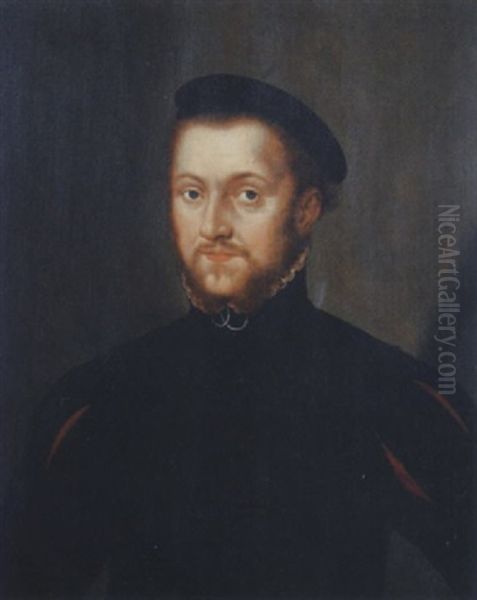
Artists directly influenced by Mor include Alonso Sánchez Coello (c. 1531–1588), who likely worked with Mor and succeeded him as Philip II's primary court painter, and Juan Pantoja de la Cruz (c. 1553–1608), Sánchez Coello's pupil. Both artists continued Mor's formal approach, emphasizing rich attire, reserved expressions, and dark backgrounds, solidifying the distinct aesthetic of Spanish royal portraiture that would eventually evolve with Velázquez in the next century. Mor's influence also extended to Portugal and, to some extent, England and the Netherlands, demonstrating the international resonance of his powerful and adaptable style. He served as a crucial conduit, transmitting and transforming artistic ideas across different European centres.
Later Years in Antwerp
Despite his extensive travels and close ties to the Spanish court, Antonis Mor spent his later years primarily in Antwerp, starting from around the late 1550s or early 1560s, although he continued to travel for commissions. He maintained a successful workshop and enjoyed considerable prosperity and respect. Records indicate he lived comfortably, reflecting his status as a highly paid international artist.
Details about his personal life are somewhat scarce, but it is known that he married a woman named Metgen (or Mechtelt), who may have been a widow. Together they had at least two children: a son, Philip Mor, who later became a canon (a type of priest), and a daughter. Mor continued to paint actively in Antwerp, producing portraits of local dignitaries and merchants alongside his ongoing court commissions. He died in Antwerp, likely between 1576 and 1578, leaving behind a substantial body of work and a significant artistic legacy.
Curiosities and Discoveries
Antonis Mor's career is punctuated by several interesting anecdotes and facts that shed light on his work and reputation. The attribution of some very early works remains a subject of scholarly discussion, highlighting the challenges of tracing an artist's initial development. The story of his portrait of Ottavio Farnese being mistaken for a work by the great Raphael underscores the high esteem in which Mor's technical skill was held, even if his style is distinct.
The circulation of multiple versions of certain portraits, like that of Prince John of Portugal, speaks to the demand for his work and the common practice of producing copies for diplomatic exchange or different family members. Perhaps one of the most intriguing episodes relates to the art market: in 1931, the Rijksmuseum in Amsterdam acquired the magnificent portraits of Sir Thomas Gresham and his wife for a substantial sum (nearly 237,000 Dutch guilders). It was later revealed that these paintings had come from the collections of Russian museums, likely sold off by the Soviet government, illustrating the complex journeys artworks can undertake and Mor's enduring value.
Conclusion: A Defining Portraitist of an Era
Antonis Mor van Dashorst, or Antonio Moro, was far more than just a skilled painter; he was a pivotal figure in 16th-century European art. Emerging from the rich artistic milieu of the Netherlands, he absorbed the lessons of both his native tradition and the Italian Renaissance, forging a powerful and influential style of portraiture. His career exemplifies the increasingly international nature of art patronage and artistic exchange during this period. As the favoured painter of the Habsburgs, particularly Philip II of Spain, he defined the visual representation of power and authority for one of Europe's dominant dynasties.
His ability to combine meticulous realism with psychological depth and regal dignity made his portraits essential tools of statecraft and personal commemoration. Through his numerous portraits of monarchs, nobles, clergy, and merchants across Europe, Mor not only documented the key figures of his time but also profoundly shaped the development of portrait painting, especially in Spain. His legacy endured through his followers and the lasting influence of his distinctive, synthesized style, securing his place as one of the undisputed masters of Renaissance portraiture.